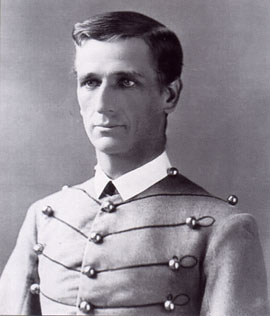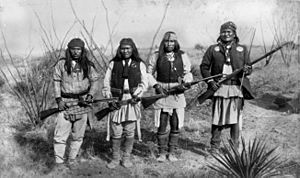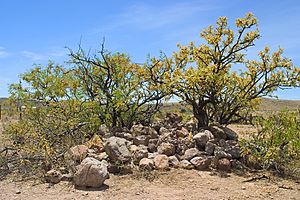Charles B. Gatewood facts for kids
Quick facts for kids
Charles Bare Gatewood
|
|
|---|---|
 |
|
| Nickname(s) | Scipio Africanus "Nanton Bse-che" translated as Big Nose Captain |
| Born | April 5, 1853 Woodstock, Virginia, US |
| Died | May 20, 1896 (aged 43) Fort Monroe, Virginia, US |
| Place of burial | |
| Allegiance | |
| Service/ |
|
| Years of service | 1877–1896 |
| Rank | First Lieutenant |
| Unit | 6th US Cavalry |
| Battles/wars |
|
| Alma mater | United States Military Academy Class of 1877 |
Charles Bare Gatewood (born April 5, 1853 – died May 20, 1896) was an American soldier. He was born in Woodstock, Virginia. After graduating from West Point, he joined the United States Army. He served in the 6th Cavalry.
Gatewood was sent to the American Southwest. There, he led groups of Apache and Navajo scouts. They helped fight against Apache groups who were not following peace treaties during the Apache Wars. In 1886, he played a very important part in ending the Geronimo Campaign. He convinced the famous Apache leader Geronimo to surrender to the army.
Gatewood faced many health problems. These were due to being outdoors in the Southwest and Dakotas. He was also badly hurt in the Johnson County War. He retired from the Army in 1895. He died a year later from stomach cancer. He was nominated for the Medal of Honor before he retired, but he did not receive it. The actor Jason Patric played him in the 1993 movie Geronimo: An American Legend.
Contents
Becoming a Soldier
Charles Gatewood was born in Woodstock, Virginia, on April 5, 1853. In 1873, he became a student at the West Point military school. There, he was nicknamed Scipio Africanus. This was because he looked like a famous Roman general with the same name.
He finished school in 1877. He became a Second Lieutenant. He was sent to the 6th US Cavalry. His first assignment was in the Southwest at Fort Wingate, New Mexico.
Serving in the Apache Wars
Gatewood led groups of Apache and Navajo Scouts in the Southwestern United States. He was respected by the Apaches. They gave him the nickname Nanton Bse-che. This means "Big-nosed Captain."
After one year, Gatewood became the leader of Apache scouts. These scouts were from the White Mountain Apache Reservation. Later, he became an assistant to General Nelson A. Miles. One of his sergeants was William Alchesay. He was a scout and a former White Mountain Chief.
Fighting Victorio
In 1879, Gatewood and his Apache scouts moved from Arizona to New Mexico. Their mission was to capture the Apache Chief Victorio. This was part of the Victorio Campaign. Gatewood's scouts fought with Victorio's group. But they were not able to capture him.
In May 1881, Gatewood went back to Virginia because he was sick. He had developed rheumatism. This was from being exposed to the harsh weather while working with the Apache scouts. On June 23, 1881, he married Georgia McCulloh in Cumberland, Maryland. He was supposed to return to duty, but he did not. So, he was considered absent from duty. Gatewood returned to the Southwest on September 17, 1881. He served under Colonel Eugene Asa Carr. They were fighting against the Cibecue and White Mountain Apaches.
The War with Geronimo

In 1882, the US Army sent General George Crook to Arizona. He was put in charge of operations against Native American groups. General Crook was very experienced. He knew that regular soldiers were not very good at fighting the Apaches. So, he used Native American scouts to fight other Native Americans. The Apaches respected Crook. They called him Nantan Lupan, meaning "Grey Wolf."
Even though many Apache tribes had been brought under control, some still fought. This time, they were led by Geronimo. Geronimo and his small group of warriors often managed to escape.
General Crook knew Gatewood was one of the army's "Best Apache Men." So, he made Gatewood the leader of the White Mountain Indian Reservation. Gatewood and Crook had different ideas about how to manage the reservation. After a disagreement with local politicians, Gatewood was moved in 1885. He was then put in charge of Navajo Scouts. That same year, General Crook left his command. General Nelson A. Miles took his place in the Geronimo Campaign.
Even though Crook and Gatewood had some disagreements, General Miles knew Gatewood was important. Gatewood knew Geronimo well. He spoke some Apache and understood their traditions. He had spent almost 10 years working with and against them.
General Miles sent Gatewood to find Geronimo. He was to ask Geronimo to talk. On July 21, Gatewood met another officer, Lieutenant James Parker. Parker said he had not seen Geronimo's trail in weeks.
Gatewood's health was getting worse. But he kept going. Parker led him to Captain Henry Ware Lawton. Lawton was on a mission to find Geronimo. It took two weeks to find Lawton's group on August 3, 1886. Lawton allowed Gatewood and his scouts to join them. Gatewood's health continued to get worse. On August 8, he asked Lawton's doctor, Leonard Wood, to let him leave the army. But the doctor refused.
On August 23, 1886, Gatewood led 25 men and two Apache scouts into the Sierra Madre mountains. They found Geronimo's camp. His group had become very small. On August 24, Gatewood approached Geronimo's camp with only two soldiers. One was George Medhurst Wratten, who spoke all Apache languages. There were also two interpreters and two Chiricahua scouts. This small group was chosen so they would not scare the Apaches.
The scouts, Kayitah and Martine, went into the camp first. Kayitah stayed as a hostage. Martine returned with Gatewood and some tobacco. Gatewood gave gifts of tobacco. Geronimo joked about Gatewood looking thin and sick. Geronimo told Gatewood, "you are always welcome in my camp." Gatewood encouraged Geronimo to stop fighting the US Army. Geronimo asked Gatewood what he would do in his situation. Gatewood advised him to "trust Miles."
Geronimo agreed to meet General Miles. His group rode with Gatewood to Lawton's camp. Lawton allowed the Apaches to keep their weapons. This was for defense against nearby Mexican troops. Lawton left to send a message to Miles. He left Lieutenant Abiel Smith in charge. Smith and Wood wanted to take the Apaches' weapons. Smith wanted to meet with Geronimo's men. But Gatewood refused. He knew Smith wanted to harm Geronimo. Smith insisted. Gatewood then threatened to fight the soldiers. Smith finally gave up.
The soldiers and Apaches arrived at Skeleton Canyon, Arizona, on September 2, 1886. General Miles arrived on September 3. Geronimo officially surrendered for the last time on September 4. After the surrender, Geronimo told Gatewood, "Good. You told the truth." The next day, Naiche surrendered. This officially ended the Apache wars in the Southwest.
Even though Gatewood was successful, Miles criticized him. Gatewood had approached Geronimo with only 6 people instead of 25. Gatewood explained that a larger group would have scared the Apache away. The city of Tucson, Arizona, held a big party to celebrate Geronimo's surrender. They invited Gatewood as the guest of honor. But Miles would not let him go. Miles made Gatewood his "Aide-de-Camp." This was to keep an eye on him. Miles also played down Gatewood's role in the surrender. He did not want to give credit to General Crook's ideas.
Later Military Service
In December 1890, Gatewood was moved to the Sixth Cavalry. His group was sent to South Dakota's Pine Ridge Agency. They were part of an operation against Sioux Native Americans. But Gatewood's group was not involved in the final battle at Wounded Knee. In January 1891, Gatewood developed rheumatism in both shoulders. This was again due to the cold weather. He could not move his arms. He had to leave in February 1891 for medical treatment.
Johnson County War Incident
By September 1891, Gatewood had recovered. He rejoined the Sixth Cavalry. They were stationed at Fort McKinney, Wyoming. Wyoming was having a conflict between ranchers and farmers. This was known as the Johnson County War. The Sixth Cavalry was sent there to help.
On May 18, 1892, some cowboys set fire to a building at the fort. They also put a bomb in a barracks stove. Gatewood was responding to the fire. He was hurt by the bomb blast. His left arm was badly injured. This made him unable to serve in the Cavalry anymore.
Death and Lasting Impact
On November 19, 1892, Gatewood was ordered to Denver, Colorado. He was waiting to leave the Army. In 1894, he took a break from the Army. He moved to Fort Myer, Virginia. In 1895, General Nelson A. Miles suggested him for the Medal of Honor. This was for his bravery in going alone into Geronimo's camp. But he was not given the award. The acting Secretary of War said Gatewood did not distinguish himself in hostile action.
In 1896, Gatewood had terrible stomach pains. He went to a hospital in Fort Monroe, Virginia. Charles Gatewood died on May 20, 1896, from stomach cancer. He was buried at Arlington National Cemetery with full military honors.
On May 23, 1896, Colonel D. S. Gordon, commander of the 6th Cavalry, issued a special order. It said:
It is with extreme sorrow and regret that the Colonel commanding the regiment announced the death of First Lieutenant Charles B. Gatewood at Fort Monroe May 20. Too much cannot be said in honor of this brave officer and it is lamentable that he should have died with only the rank of a Lieutenant, after his brilliant services to the Government. That no material advantages reverted to him is regretted by every officer of his regiment, who extend to his bereaved family their most profound, earnest and sincere sympathy. As a mark of respect to his memory, the officers of the regiment will wear the usual badge of mourning for the period of 30 days.
Gatewood's son, Charles B. Gatewood, Jr. (1883–1953), also joined the Army. He became a colonel. He worked to make sure his father's actions were recognized. He later put together and published his father's memories.
Charles Gatewood has been shown in movies and TV shows.
- In 1954, Brett King played him in the TV series Stories of the Century.
- In 1993, Jason Patric played him in the film Geronimo: An American Legend.
- In 1960, Robert Cummings played him in an episode of Dick Powell's Zane Grey Theatre.
Images for kids



